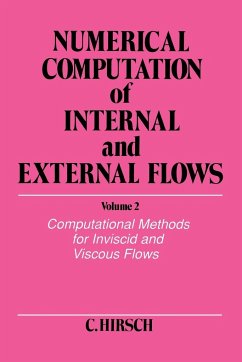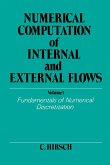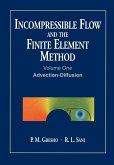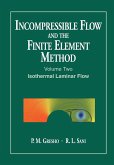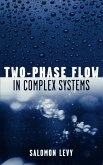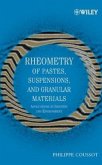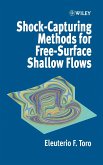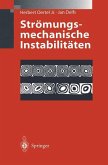Charles Hirsch
Numerical Computation of Internal and External Flows, Volume 2
Computational Methods for Inviscid and Viscous Flows
Charles Hirsch
Numerical Computation of Internal and External Flows, Volume 2
Computational Methods for Inviscid and Viscous Flows
- Broschiertes Buch
- Merkliste
- Auf die Merkliste
- Bewerten Bewerten
- Teilen
- Produkt teilen
- Produkterinnerung
- Produkterinnerung
This volume deals with the applications of computational methods to the problems of fluid dynamics. It complements the first volume to provide an excellent reference source in this vital and fast growing area. The author includes material on the numerical computation of potential flows and on the most up-to-date methods for Euler and Navier-Stokes equations. The coverage is comprehensive and includes detailed discussion of numerical techniques and algorithms, including implementation topics such as boundary conditions. Problems are given at the end of each chapter and there are comprehensive…mehr
Andere Kunden interessierten sich auch für
![Numerical Computation of Internal and External Flows, Volume 1 Numerical Computation of Internal and External Flows, Volume 1]() Charles HirschNumerical Computation of Internal and External Flows, Volume 1357,99 €
Charles HirschNumerical Computation of Internal and External Flows, Volume 1357,99 €![Incompressible Flow and the Finite Element Method, Volume 1 Incompressible Flow and the Finite Element Method, Volume 1]() P. M. GreshoIncompressible Flow and the Finite Element Method, Volume 1184,99 €
P. M. GreshoIncompressible Flow and the Finite Element Method, Volume 1184,99 €![Incompressible Flow and the Finite Element Method, Volume 2 Incompressible Flow and the Finite Element Method, Volume 2]() P. M. GreshoIncompressible Flow and the Finite Element Method, Volume 2220,99 €
P. M. GreshoIncompressible Flow and the Finite Element Method, Volume 2220,99 €![Two-Phase Flow in Complex Systems Two-Phase Flow in Complex Systems]() Salomon LevyTwo-Phase Flow in Complex Systems183,99 €
Salomon LevyTwo-Phase Flow in Complex Systems183,99 €![Rheometry of Pastes, Suspensions, and Granular Materials Rheometry of Pastes, Suspensions, and Granular Materials]() Philippe CoussotRheometry of Pastes, Suspensions, and Granular Materials175,99 €
Philippe CoussotRheometry of Pastes, Suspensions, and Granular Materials175,99 €![Shock-Capturing Methods for Free-Surface Shallow Flows Shock-Capturing Methods for Free-Surface Shallow Flows]() Eleuterio F. ToroShock-Capturing Methods for Free-Surface Shallow Flows323,99 €
Eleuterio F. ToroShock-Capturing Methods for Free-Surface Shallow Flows323,99 €![Strömungsmechanische Instabilitäten Strömungsmechanische Instabilitäten]() Herbert OertelStrömungsmechanische Instabilitäten54,99 €
Herbert OertelStrömungsmechanische Instabilitäten54,99 €-
-
-
This volume deals with the applications of computational methods to the problems of fluid dynamics. It complements the first volume to provide an excellent reference source in this vital and fast growing area. The author includes material on the numerical computation of potential flows and on the most up-to-date methods for Euler and Navier-Stokes equations. The coverage is comprehensive and includes detailed discussion of numerical techniques and algorithms, including implementation topics such as boundary conditions. Problems are given at the end of each chapter and there are comprehensive reference lists. Of increasing interest, the subject has powerful implications in such crucial fields as aeronauticsand industrial fluid dynamics.
Hinweis: Dieser Artikel kann nur an eine deutsche Lieferadresse ausgeliefert werden.
Hinweis: Dieser Artikel kann nur an eine deutsche Lieferadresse ausgeliefert werden.
Produktdetails
- Produktdetails
- Numerical Computation of Internal and External Flows 2
- Verlag: Wiley & Sons
- 1. Auflage
- Seitenzahl: 720
- Erscheinungstermin: 8. Januar 1991
- Englisch
- Abmessung: 229mm x 152mm x 42mm
- Gewicht: 1026g
- ISBN-13: 9780471924524
- ISBN-10: 0471924520
- Artikelnr.: 06997868
- Herstellerkennzeichnung
- Libri GmbH
- Europaallee 1
- 36244 Bad Hersfeld
- gpsr@libri.de
- Numerical Computation of Internal and External Flows 2
- Verlag: Wiley & Sons
- 1. Auflage
- Seitenzahl: 720
- Erscheinungstermin: 8. Januar 1991
- Englisch
- Abmessung: 229mm x 152mm x 42mm
- Gewicht: 1026g
- ISBN-13: 9780471924524
- ISBN-10: 0471924520
- Artikelnr.: 06997868
- Herstellerkennzeichnung
- Libri GmbH
- Europaallee 1
- 36244 Bad Hersfeld
- gpsr@libri.de
Charles Sidney Hirsch was an American forensic pathologist who served as the Chief Medical Examiner of New York City from 1989 until 2013. He oversaw the identification of victims from the World Trade Center attacks in 2001.
Preface xv
Nomenclature xix
Part V: The Numerical Computation of Potential Flows 1
Chapter 13 The Mathematical Formulations of the Potential Flow Model 4
13.1 Conservative Form of the Potential Equation 4
13.2 The Non-conservative Form of the Isentropic Potential Flow Model 6
13.2.1 Small-perturbation potential equation 7
13.3 The Mathematical Properties of the Potential Equation 9
13.3.1 Unsteady potential flow 9
13.3.2 Steady potential flow 9
13.4 Boundary Conditions 14
13.4.1 Solid wall boundary condition 14
13.4.2 Far field conditions 15
13.4.3 Cascade and channel flows 17
13.4.4 Circulation and Kutta condition 18
13.5 Integral or Weak Formulation of the Potential Model 18
13.5.1 Bateman variational principle 19
13.5.2 Analysis of some properties of the variational integral 20
Chapter 14 The Discretization of the Subsonic Potential Equation 26
14.1 Finite Difference Formulation 27
14.1.1 Numerical estimation of the density 29
14.1.2 Curvilinear mesh 31
14.1.3 Consistency of the discretization of metric coefficients 34
14.1.4 Boundary conditions-curved solid wall 36
14.2 Finite Volume Formulation 38
14.2.1 Jameson and Caughey's finite volume method 39
14.3 Finite Element Formulation 42
14.3.1 The finite element-Galerkin method 43
14.3.2 Least squares or optimal control approach 47
14.4 Iteration Scheme for the Density 47
Chapter 15 The Computation of Stationary Transonic Potential Flows 57
15.1 The Treatment of the Supersonic Region: Artificial Viscosity-Density
and Flux Upwinding 61
15.1.1 Artificial viscosity-non-conservative potential equation 62
15.1.2 Artificial viscosity-conservative potential equation 66
15.1.3 Artificial compressibility 67
15.1.4 Artificial flux or flux upwinding 70
15.2 Iteration Schemes for Potential Flow Computations 77
15.2.1 Line relaxation schemes 77
15.2.2 Guidelines for resolution of the discretized potential equation 81
15.2.3 The alternating direction implicit method-approximate factorization
schemes 88
15.2.4 Other techniques-multigrid methods 98
15.3 Non-uniqueness and Non-isentropic Potential Models 104
15.3.1 Isentropic shocks 105
15.3.2 Non-uniqueness and breakdown of the transonic potential flow model
105
15.3.3 Non-isentropic potential models 112
15.4 Conclusions 117
Part VI: The Numerical Solution of the System of Euler Equations 125
Chapter 16 The Mathematical Formulation of the System of Euler Equations
132
16.1 The Conservative Formulation of the Euler Equations 132
16.1.1 Integral conservative formulation of the Euler equations 133
16.1.2 Differential conservative formulation 134
16.1.3 Cartesian system of coordinates 134
16.1.4 Discontinuities and Rankine-Hugoniot relations-entropy condition 135
16.2 The Quasi-linear Formulation of the Euler Equations 138
16.2.l The Jacobian matrices for conservative variables 138
16.2.2 The Jacobian matrices for primitive variables 145
16.2.3 Transformation matrices between conservative and non-conservative
variables 147
16.3 The Characteristic Formulation of the Euler Equations-Eigenvalues and
Compatibility Relations 150
16.3.1 General properties of characteristics 151
16.3.2 Diagonalization of the Jacobian matrices 153
16.3.3 Compatibility equations 154
16.4 Characteristic Variables and Eigenvalues for One-dimensional Flows 157
16.4.1 Eigenvalues and eigenvectors of Jacobian matrix 158
16.4.2 Characteristic variables 162
16.4.3 Characteristics in the xt-plane-shocks and contact discontinuities
168
16.4.4 Physical boundary conditions 171
16.4.5 Characteristics and simple wave solutions 173
16.5 Eigenvalues and Compatibility Relations in Multidimensional Flows 176
16.5.1 Jacobian eigenvalues and eigenvectors in primitive variables 177
16.5.2 Diagonalization of the conservative Jacobians 180
16.5.3 Mach cone and compatibility relations 184
16.5.4 Boundary conditions 191
16.6 Some Simple Exact Reference Solutions for One-dimensional Inviscid
Flows 196
16.6.1 The linear wave equation 196
16.6.2 The inviscid Burgers equation 196
16.6.3 The shock tube problem or Riemann problem 204
16.6.4 The quasi-one-dimensional nozzle flow 211
Chapter 17 The Lax-Wendroff Family of Space-centred Schemes 224
17.1 The Space-centred Explicit Schemes of First Order 226
17.1.1 The one-dimensional Lax-Friedrichs scheme 226
17.1.2 The two-dimensional Lax-Friedrichs scheme 229
17.1.3 Corrected viscosity scheme 233
17.2 The Space-centred Explicit Schemes of Second Order 234
17.2.1 The basic one-dimensional Lax-Wendroff scheme 234
17.2.2 The two-step Lax-Wendroff schemes in one dimension 238
17.2.3 Lerat and Peyret's family of non-linear two-step Lax-Wendroff
schemes 246
17.2.4 One-step Lax-Wendroff schemes in two dimensions 251
17.2.5 Two-step Lax-Wendroff schemes in two dimensions 258
17.3 The Concept of Artificial Dissipation or Artificial Viscosity 272
17.3.1 General form of artificial dissipation terms 273
17.3.2 Von Neumann-Richtmyer artificial viscosity 274
17.3.3 Higher-order artificial viscosities 279
17.4 Lerat's Implicit Schemes of Lax-Wendroff Type 283
17.4.1 Analysis for linear systems in one dimension 285
17.4.2 Construction of the family of schemes 288
17.4.3 Extension to non-linear systems in conservation form 292
17.4.4 Extension to multi-dimensional flows 296
17.5 Summary 296
Chapter 18 The Central Schemes with Independent Time Integration 307
18.1 The Central Second-order Implicit Schemes of Beam and Warming in One
Dimension 309
18.1.1 The basic Beam and Warming schemes 310
18.1.2 Addition of artificial viscosity 315
18.2 The Multidimensional Implicit Beam and Warming Schemes 326
18.2.1 The diagonal variant of Pulliam and Chaussee 328
18.3 Jameson's Multistage Method 334
18.3.1 Time integration 334
18.3.2 Convergence acceleration to steady state 335
Chapter 19 The Treatment of Boundary Conditions 344
19.1 One-dimensional Boundary Treatment for Euler Equations 345
19.1.1 Characteristic boundary conditions 346
19.1.2 Compatibility relations 347
19.1.3 Characteristic boundary conditions as a function of conservative and
primitive variables 349
19.1.4 Extrapolation methods 353
19.1.5 Practical implementation methods for numerical boundary conditions
357
19.1.6 Nonreflecting boundary conditions 369
19.2 Multidimensional Boundary Treatment 372
19.2.1 Physical and numerical boundary conditions 372
19.2.2 Multidimensional compatibility relations 376
19.2.3 Farfield treatment for steadystate flows 377
19.2.4 Solid wall boundary 379
19.2.5 Nonreflective boundary conditions 384
19.3 The Far-field Boundary Corrections 385
19.4 The Kutta Condition 395
19.5 Summary 401
Chapter 20 Upwind Schemes for the Euler Equations 408
20.1 The Basic Principles of Upwind Schemes 409
20.2 One-dimensional Flux Vector Splitting 415
20.2.1 Steger and Warming flux vector splitting 415
20.2.2 Properties of split flux vectors 417
20.2.3 Van Leer's flux splitting 420
20.2.4 Non-reflective boundary conditions and split fluxes 425
20.3 One-dimensional Upwind Discretizations Based on Flux Vector Splitting
426
20.3.1 First-order explicit upwind schemes 426
20.3.2 Stability conditions for first-order flux vector splitting schemes
428
20.3.3 Non-conservative firstorder upwind schemes 438
20.4 Multi-dimensional Flux Vector Splitting 438
20.4.1 Steger and Warming flux splitting 440
20.4.2 Van Leer flux splitting 440
20.4.3 Arbitrary meshes 441
20.5 The Godunov-type Schemes 443
20.5.1 The basic Godunov scheme 444
20.5.2 Osher's approximate Riemann solver 453
20.5.3 Roe's approximate Riemann solver 460
20.5.4 Other Godunov-type methods 469
20.5.5 Summary 472
20.6 First-order Implicit Upwind Schemes 473
20.7 Multi-dimensional First-order Upwind Schemes 475
Chapter 21 Second-order Upwind and High-resolution Schemes 493
21.1 General Formulation of Higher-order Upwind Schemes 494
21.1.1 Higher-order projection stages-variable extrapolation or MUSCL
approach 495
21.1.2 Numerical flux for higher-order upwind schemes 498
21.1.3 Second-order space- and time-accurate upwind schemes based on
variable extrapolation 499
21.1.4 Linearized analysis of second-order upwind schemes 502
21.1.5 Numerical flux for higher-order upwind schemes-flux extrapolation
504
21.1.6 Implicit second-order upwind schemes 512
21.1.7 Implicit second-order upwind schemes in two dimensions 514
21.1.8 Summary 516
21.2 The Definition of High-resolution Schemes 517
21.2.1 The generalized entropy condition for inviscid equations 519
21.2.2 Monotonicity condition 525
21.2.3 Total variation diminishing (TVD)schemes 528
21.3 Second-order TVD Semi-discretized Schemes with Limiters 536
21.3.1 Definition of limiters for the linear convection equation 537
21.3.2 General definition of flux limiters 550
21.3.3 Limiters for variable extrapolation-MUSCL-method 552
21.4 Timeintegration Methods for TVD Schemes 556
21.4.1 Explicit TVD schemes of first-order accuracy in time 557
21.4.2 Implicit TVD schemes 558
21.4.3 Explicit second-order TVD schemes 560
21.4.4 TVD schemes and artificial dissipation 564
21.4.5 TVD limiters and the entropy condition 568
21.5 Extension to Non-linear Systems and to Multi-dimensions 570
21.6 Conclusions to Part VI 583
Part VII: The Numerical Solution of the Navier-Stokes Equations 595
Chapter 22 The Properties of the System of Navier-Stokes Equations 597
22.1 Mathematical Formulation of the Navier-Stokes Equations 597
22.1.1 Conservative form of the Navier-Stokes equations 597
22.1.2 Integral form of the Navier-Stokes equations 599
22.1.3 Shock waves and contact layers 600
22.1.4 Mathematical properties and boundary conditions 601
22.2 Reynolds-averaged Navier-Stokes Equations 603
22.2.1 Turbulent-averaged energy equation 604
22.3 Turbulence Models 606
22.3.1 Algebraic models 608
22.3.2 One- and two-equation models-k-¿ models 613
22.3.3 Algebraic Reynolds stress models 615
22.4 Some Exact One-dimensional Solutions 618
22.4.1 Solutions to the linear convection-diffusion equation 618
22.4.2 Solutions to Burgers equation 620
22.4.3 Other simple test cases 621
Chapter 23 Discretization Methods for the Navier-Stokes Equations 624
23.1 Discretization of Viscous and Heat Conduction Terms 625
23.2 Time-dependent Methods for Compressible Navier-Stokes Equations 627
23.2.1 First-order explicit central schemes 628
23.2.2 One-step Lax-Wendroff schemes 629
23.2.3 Two-step Lax-Wendroff schemes 630
23.2.4 Central schemes with separate space and time discretization 636
23.2.5 Upwind schemes 648
23.3 Discretization of the Incompressible Navier-Stokes Equations 654
23.3.1 Incompressible Navier-Stokes equations 654
23.3.2 Pseudo-compressibility method 656
23.3.3 Pressure correction methods 661
23.3.4 Selection of the space discretization 666
23.4 Conclusions to Part VII 674
Index 685
Nomenclature xix
Part V: The Numerical Computation of Potential Flows 1
Chapter 13 The Mathematical Formulations of the Potential Flow Model 4
13.1 Conservative Form of the Potential Equation 4
13.2 The Non-conservative Form of the Isentropic Potential Flow Model 6
13.2.1 Small-perturbation potential equation 7
13.3 The Mathematical Properties of the Potential Equation 9
13.3.1 Unsteady potential flow 9
13.3.2 Steady potential flow 9
13.4 Boundary Conditions 14
13.4.1 Solid wall boundary condition 14
13.4.2 Far field conditions 15
13.4.3 Cascade and channel flows 17
13.4.4 Circulation and Kutta condition 18
13.5 Integral or Weak Formulation of the Potential Model 18
13.5.1 Bateman variational principle 19
13.5.2 Analysis of some properties of the variational integral 20
Chapter 14 The Discretization of the Subsonic Potential Equation 26
14.1 Finite Difference Formulation 27
14.1.1 Numerical estimation of the density 29
14.1.2 Curvilinear mesh 31
14.1.3 Consistency of the discretization of metric coefficients 34
14.1.4 Boundary conditions-curved solid wall 36
14.2 Finite Volume Formulation 38
14.2.1 Jameson and Caughey's finite volume method 39
14.3 Finite Element Formulation 42
14.3.1 The finite element-Galerkin method 43
14.3.2 Least squares or optimal control approach 47
14.4 Iteration Scheme for the Density 47
Chapter 15 The Computation of Stationary Transonic Potential Flows 57
15.1 The Treatment of the Supersonic Region: Artificial Viscosity-Density
and Flux Upwinding 61
15.1.1 Artificial viscosity-non-conservative potential equation 62
15.1.2 Artificial viscosity-conservative potential equation 66
15.1.3 Artificial compressibility 67
15.1.4 Artificial flux or flux upwinding 70
15.2 Iteration Schemes for Potential Flow Computations 77
15.2.1 Line relaxation schemes 77
15.2.2 Guidelines for resolution of the discretized potential equation 81
15.2.3 The alternating direction implicit method-approximate factorization
schemes 88
15.2.4 Other techniques-multigrid methods 98
15.3 Non-uniqueness and Non-isentropic Potential Models 104
15.3.1 Isentropic shocks 105
15.3.2 Non-uniqueness and breakdown of the transonic potential flow model
105
15.3.3 Non-isentropic potential models 112
15.4 Conclusions 117
Part VI: The Numerical Solution of the System of Euler Equations 125
Chapter 16 The Mathematical Formulation of the System of Euler Equations
132
16.1 The Conservative Formulation of the Euler Equations 132
16.1.1 Integral conservative formulation of the Euler equations 133
16.1.2 Differential conservative formulation 134
16.1.3 Cartesian system of coordinates 134
16.1.4 Discontinuities and Rankine-Hugoniot relations-entropy condition 135
16.2 The Quasi-linear Formulation of the Euler Equations 138
16.2.l The Jacobian matrices for conservative variables 138
16.2.2 The Jacobian matrices for primitive variables 145
16.2.3 Transformation matrices between conservative and non-conservative
variables 147
16.3 The Characteristic Formulation of the Euler Equations-Eigenvalues and
Compatibility Relations 150
16.3.1 General properties of characteristics 151
16.3.2 Diagonalization of the Jacobian matrices 153
16.3.3 Compatibility equations 154
16.4 Characteristic Variables and Eigenvalues for One-dimensional Flows 157
16.4.1 Eigenvalues and eigenvectors of Jacobian matrix 158
16.4.2 Characteristic variables 162
16.4.3 Characteristics in the xt-plane-shocks and contact discontinuities
168
16.4.4 Physical boundary conditions 171
16.4.5 Characteristics and simple wave solutions 173
16.5 Eigenvalues and Compatibility Relations in Multidimensional Flows 176
16.5.1 Jacobian eigenvalues and eigenvectors in primitive variables 177
16.5.2 Diagonalization of the conservative Jacobians 180
16.5.3 Mach cone and compatibility relations 184
16.5.4 Boundary conditions 191
16.6 Some Simple Exact Reference Solutions for One-dimensional Inviscid
Flows 196
16.6.1 The linear wave equation 196
16.6.2 The inviscid Burgers equation 196
16.6.3 The shock tube problem or Riemann problem 204
16.6.4 The quasi-one-dimensional nozzle flow 211
Chapter 17 The Lax-Wendroff Family of Space-centred Schemes 224
17.1 The Space-centred Explicit Schemes of First Order 226
17.1.1 The one-dimensional Lax-Friedrichs scheme 226
17.1.2 The two-dimensional Lax-Friedrichs scheme 229
17.1.3 Corrected viscosity scheme 233
17.2 The Space-centred Explicit Schemes of Second Order 234
17.2.1 The basic one-dimensional Lax-Wendroff scheme 234
17.2.2 The two-step Lax-Wendroff schemes in one dimension 238
17.2.3 Lerat and Peyret's family of non-linear two-step Lax-Wendroff
schemes 246
17.2.4 One-step Lax-Wendroff schemes in two dimensions 251
17.2.5 Two-step Lax-Wendroff schemes in two dimensions 258
17.3 The Concept of Artificial Dissipation or Artificial Viscosity 272
17.3.1 General form of artificial dissipation terms 273
17.3.2 Von Neumann-Richtmyer artificial viscosity 274
17.3.3 Higher-order artificial viscosities 279
17.4 Lerat's Implicit Schemes of Lax-Wendroff Type 283
17.4.1 Analysis for linear systems in one dimension 285
17.4.2 Construction of the family of schemes 288
17.4.3 Extension to non-linear systems in conservation form 292
17.4.4 Extension to multi-dimensional flows 296
17.5 Summary 296
Chapter 18 The Central Schemes with Independent Time Integration 307
18.1 The Central Second-order Implicit Schemes of Beam and Warming in One
Dimension 309
18.1.1 The basic Beam and Warming schemes 310
18.1.2 Addition of artificial viscosity 315
18.2 The Multidimensional Implicit Beam and Warming Schemes 326
18.2.1 The diagonal variant of Pulliam and Chaussee 328
18.3 Jameson's Multistage Method 334
18.3.1 Time integration 334
18.3.2 Convergence acceleration to steady state 335
Chapter 19 The Treatment of Boundary Conditions 344
19.1 One-dimensional Boundary Treatment for Euler Equations 345
19.1.1 Characteristic boundary conditions 346
19.1.2 Compatibility relations 347
19.1.3 Characteristic boundary conditions as a function of conservative and
primitive variables 349
19.1.4 Extrapolation methods 353
19.1.5 Practical implementation methods for numerical boundary conditions
357
19.1.6 Nonreflecting boundary conditions 369
19.2 Multidimensional Boundary Treatment 372
19.2.1 Physical and numerical boundary conditions 372
19.2.2 Multidimensional compatibility relations 376
19.2.3 Farfield treatment for steadystate flows 377
19.2.4 Solid wall boundary 379
19.2.5 Nonreflective boundary conditions 384
19.3 The Far-field Boundary Corrections 385
19.4 The Kutta Condition 395
19.5 Summary 401
Chapter 20 Upwind Schemes for the Euler Equations 408
20.1 The Basic Principles of Upwind Schemes 409
20.2 One-dimensional Flux Vector Splitting 415
20.2.1 Steger and Warming flux vector splitting 415
20.2.2 Properties of split flux vectors 417
20.2.3 Van Leer's flux splitting 420
20.2.4 Non-reflective boundary conditions and split fluxes 425
20.3 One-dimensional Upwind Discretizations Based on Flux Vector Splitting
426
20.3.1 First-order explicit upwind schemes 426
20.3.2 Stability conditions for first-order flux vector splitting schemes
428
20.3.3 Non-conservative firstorder upwind schemes 438
20.4 Multi-dimensional Flux Vector Splitting 438
20.4.1 Steger and Warming flux splitting 440
20.4.2 Van Leer flux splitting 440
20.4.3 Arbitrary meshes 441
20.5 The Godunov-type Schemes 443
20.5.1 The basic Godunov scheme 444
20.5.2 Osher's approximate Riemann solver 453
20.5.3 Roe's approximate Riemann solver 460
20.5.4 Other Godunov-type methods 469
20.5.5 Summary 472
20.6 First-order Implicit Upwind Schemes 473
20.7 Multi-dimensional First-order Upwind Schemes 475
Chapter 21 Second-order Upwind and High-resolution Schemes 493
21.1 General Formulation of Higher-order Upwind Schemes 494
21.1.1 Higher-order projection stages-variable extrapolation or MUSCL
approach 495
21.1.2 Numerical flux for higher-order upwind schemes 498
21.1.3 Second-order space- and time-accurate upwind schemes based on
variable extrapolation 499
21.1.4 Linearized analysis of second-order upwind schemes 502
21.1.5 Numerical flux for higher-order upwind schemes-flux extrapolation
504
21.1.6 Implicit second-order upwind schemes 512
21.1.7 Implicit second-order upwind schemes in two dimensions 514
21.1.8 Summary 516
21.2 The Definition of High-resolution Schemes 517
21.2.1 The generalized entropy condition for inviscid equations 519
21.2.2 Monotonicity condition 525
21.2.3 Total variation diminishing (TVD)schemes 528
21.3 Second-order TVD Semi-discretized Schemes with Limiters 536
21.3.1 Definition of limiters for the linear convection equation 537
21.3.2 General definition of flux limiters 550
21.3.3 Limiters for variable extrapolation-MUSCL-method 552
21.4 Timeintegration Methods for TVD Schemes 556
21.4.1 Explicit TVD schemes of first-order accuracy in time 557
21.4.2 Implicit TVD schemes 558
21.4.3 Explicit second-order TVD schemes 560
21.4.4 TVD schemes and artificial dissipation 564
21.4.5 TVD limiters and the entropy condition 568
21.5 Extension to Non-linear Systems and to Multi-dimensions 570
21.6 Conclusions to Part VI 583
Part VII: The Numerical Solution of the Navier-Stokes Equations 595
Chapter 22 The Properties of the System of Navier-Stokes Equations 597
22.1 Mathematical Formulation of the Navier-Stokes Equations 597
22.1.1 Conservative form of the Navier-Stokes equations 597
22.1.2 Integral form of the Navier-Stokes equations 599
22.1.3 Shock waves and contact layers 600
22.1.4 Mathematical properties and boundary conditions 601
22.2 Reynolds-averaged Navier-Stokes Equations 603
22.2.1 Turbulent-averaged energy equation 604
22.3 Turbulence Models 606
22.3.1 Algebraic models 608
22.3.2 One- and two-equation models-k-¿ models 613
22.3.3 Algebraic Reynolds stress models 615
22.4 Some Exact One-dimensional Solutions 618
22.4.1 Solutions to the linear convection-diffusion equation 618
22.4.2 Solutions to Burgers equation 620
22.4.3 Other simple test cases 621
Chapter 23 Discretization Methods for the Navier-Stokes Equations 624
23.1 Discretization of Viscous and Heat Conduction Terms 625
23.2 Time-dependent Methods for Compressible Navier-Stokes Equations 627
23.2.1 First-order explicit central schemes 628
23.2.2 One-step Lax-Wendroff schemes 629
23.2.3 Two-step Lax-Wendroff schemes 630
23.2.4 Central schemes with separate space and time discretization 636
23.2.5 Upwind schemes 648
23.3 Discretization of the Incompressible Navier-Stokes Equations 654
23.3.1 Incompressible Navier-Stokes equations 654
23.3.2 Pseudo-compressibility method 656
23.3.3 Pressure correction methods 661
23.3.4 Selection of the space discretization 666
23.4 Conclusions to Part VII 674
Index 685
Preface xv
Nomenclature xix
Part V: The Numerical Computation of Potential Flows 1
Chapter 13 The Mathematical Formulations of the Potential Flow Model 4
13.1 Conservative Form of the Potential Equation 4
13.2 The Non-conservative Form of the Isentropic Potential Flow Model 6
13.2.1 Small-perturbation potential equation 7
13.3 The Mathematical Properties of the Potential Equation 9
13.3.1 Unsteady potential flow 9
13.3.2 Steady potential flow 9
13.4 Boundary Conditions 14
13.4.1 Solid wall boundary condition 14
13.4.2 Far field conditions 15
13.4.3 Cascade and channel flows 17
13.4.4 Circulation and Kutta condition 18
13.5 Integral or Weak Formulation of the Potential Model 18
13.5.1 Bateman variational principle 19
13.5.2 Analysis of some properties of the variational integral 20
Chapter 14 The Discretization of the Subsonic Potential Equation 26
14.1 Finite Difference Formulation 27
14.1.1 Numerical estimation of the density 29
14.1.2 Curvilinear mesh 31
14.1.3 Consistency of the discretization of metric coefficients 34
14.1.4 Boundary conditions-curved solid wall 36
14.2 Finite Volume Formulation 38
14.2.1 Jameson and Caughey's finite volume method 39
14.3 Finite Element Formulation 42
14.3.1 The finite element-Galerkin method 43
14.3.2 Least squares or optimal control approach 47
14.4 Iteration Scheme for the Density 47
Chapter 15 The Computation of Stationary Transonic Potential Flows 57
15.1 The Treatment of the Supersonic Region: Artificial Viscosity-Density
and Flux Upwinding 61
15.1.1 Artificial viscosity-non-conservative potential equation 62
15.1.2 Artificial viscosity-conservative potential equation 66
15.1.3 Artificial compressibility 67
15.1.4 Artificial flux or flux upwinding 70
15.2 Iteration Schemes for Potential Flow Computations 77
15.2.1 Line relaxation schemes 77
15.2.2 Guidelines for resolution of the discretized potential equation 81
15.2.3 The alternating direction implicit method-approximate factorization
schemes 88
15.2.4 Other techniques-multigrid methods 98
15.3 Non-uniqueness and Non-isentropic Potential Models 104
15.3.1 Isentropic shocks 105
15.3.2 Non-uniqueness and breakdown of the transonic potential flow model
105
15.3.3 Non-isentropic potential models 112
15.4 Conclusions 117
Part VI: The Numerical Solution of the System of Euler Equations 125
Chapter 16 The Mathematical Formulation of the System of Euler Equations
132
16.1 The Conservative Formulation of the Euler Equations 132
16.1.1 Integral conservative formulation of the Euler equations 133
16.1.2 Differential conservative formulation 134
16.1.3 Cartesian system of coordinates 134
16.1.4 Discontinuities and Rankine-Hugoniot relations-entropy condition 135
16.2 The Quasi-linear Formulation of the Euler Equations 138
16.2.l The Jacobian matrices for conservative variables 138
16.2.2 The Jacobian matrices for primitive variables 145
16.2.3 Transformation matrices between conservative and non-conservative
variables 147
16.3 The Characteristic Formulation of the Euler Equations-Eigenvalues and
Compatibility Relations 150
16.3.1 General properties of characteristics 151
16.3.2 Diagonalization of the Jacobian matrices 153
16.3.3 Compatibility equations 154
16.4 Characteristic Variables and Eigenvalues for One-dimensional Flows 157
16.4.1 Eigenvalues and eigenvectors of Jacobian matrix 158
16.4.2 Characteristic variables 162
16.4.3 Characteristics in the xt-plane-shocks and contact discontinuities
168
16.4.4 Physical boundary conditions 171
16.4.5 Characteristics and simple wave solutions 173
16.5 Eigenvalues and Compatibility Relations in Multidimensional Flows 176
16.5.1 Jacobian eigenvalues and eigenvectors in primitive variables 177
16.5.2 Diagonalization of the conservative Jacobians 180
16.5.3 Mach cone and compatibility relations 184
16.5.4 Boundary conditions 191
16.6 Some Simple Exact Reference Solutions for One-dimensional Inviscid
Flows 196
16.6.1 The linear wave equation 196
16.6.2 The inviscid Burgers equation 196
16.6.3 The shock tube problem or Riemann problem 204
16.6.4 The quasi-one-dimensional nozzle flow 211
Chapter 17 The Lax-Wendroff Family of Space-centred Schemes 224
17.1 The Space-centred Explicit Schemes of First Order 226
17.1.1 The one-dimensional Lax-Friedrichs scheme 226
17.1.2 The two-dimensional Lax-Friedrichs scheme 229
17.1.3 Corrected viscosity scheme 233
17.2 The Space-centred Explicit Schemes of Second Order 234
17.2.1 The basic one-dimensional Lax-Wendroff scheme 234
17.2.2 The two-step Lax-Wendroff schemes in one dimension 238
17.2.3 Lerat and Peyret's family of non-linear two-step Lax-Wendroff
schemes 246
17.2.4 One-step Lax-Wendroff schemes in two dimensions 251
17.2.5 Two-step Lax-Wendroff schemes in two dimensions 258
17.3 The Concept of Artificial Dissipation or Artificial Viscosity 272
17.3.1 General form of artificial dissipation terms 273
17.3.2 Von Neumann-Richtmyer artificial viscosity 274
17.3.3 Higher-order artificial viscosities 279
17.4 Lerat's Implicit Schemes of Lax-Wendroff Type 283
17.4.1 Analysis for linear systems in one dimension 285
17.4.2 Construction of the family of schemes 288
17.4.3 Extension to non-linear systems in conservation form 292
17.4.4 Extension to multi-dimensional flows 296
17.5 Summary 296
Chapter 18 The Central Schemes with Independent Time Integration 307
18.1 The Central Second-order Implicit Schemes of Beam and Warming in One
Dimension 309
18.1.1 The basic Beam and Warming schemes 310
18.1.2 Addition of artificial viscosity 315
18.2 The Multidimensional Implicit Beam and Warming Schemes 326
18.2.1 The diagonal variant of Pulliam and Chaussee 328
18.3 Jameson's Multistage Method 334
18.3.1 Time integration 334
18.3.2 Convergence acceleration to steady state 335
Chapter 19 The Treatment of Boundary Conditions 344
19.1 One-dimensional Boundary Treatment for Euler Equations 345
19.1.1 Characteristic boundary conditions 346
19.1.2 Compatibility relations 347
19.1.3 Characteristic boundary conditions as a function of conservative and
primitive variables 349
19.1.4 Extrapolation methods 353
19.1.5 Practical implementation methods for numerical boundary conditions
357
19.1.6 Nonreflecting boundary conditions 369
19.2 Multidimensional Boundary Treatment 372
19.2.1 Physical and numerical boundary conditions 372
19.2.2 Multidimensional compatibility relations 376
19.2.3 Farfield treatment for steadystate flows 377
19.2.4 Solid wall boundary 379
19.2.5 Nonreflective boundary conditions 384
19.3 The Far-field Boundary Corrections 385
19.4 The Kutta Condition 395
19.5 Summary 401
Chapter 20 Upwind Schemes for the Euler Equations 408
20.1 The Basic Principles of Upwind Schemes 409
20.2 One-dimensional Flux Vector Splitting 415
20.2.1 Steger and Warming flux vector splitting 415
20.2.2 Properties of split flux vectors 417
20.2.3 Van Leer's flux splitting 420
20.2.4 Non-reflective boundary conditions and split fluxes 425
20.3 One-dimensional Upwind Discretizations Based on Flux Vector Splitting
426
20.3.1 First-order explicit upwind schemes 426
20.3.2 Stability conditions for first-order flux vector splitting schemes
428
20.3.3 Non-conservative firstorder upwind schemes 438
20.4 Multi-dimensional Flux Vector Splitting 438
20.4.1 Steger and Warming flux splitting 440
20.4.2 Van Leer flux splitting 440
20.4.3 Arbitrary meshes 441
20.5 The Godunov-type Schemes 443
20.5.1 The basic Godunov scheme 444
20.5.2 Osher's approximate Riemann solver 453
20.5.3 Roe's approximate Riemann solver 460
20.5.4 Other Godunov-type methods 469
20.5.5 Summary 472
20.6 First-order Implicit Upwind Schemes 473
20.7 Multi-dimensional First-order Upwind Schemes 475
Chapter 21 Second-order Upwind and High-resolution Schemes 493
21.1 General Formulation of Higher-order Upwind Schemes 494
21.1.1 Higher-order projection stages-variable extrapolation or MUSCL
approach 495
21.1.2 Numerical flux for higher-order upwind schemes 498
21.1.3 Second-order space- and time-accurate upwind schemes based on
variable extrapolation 499
21.1.4 Linearized analysis of second-order upwind schemes 502
21.1.5 Numerical flux for higher-order upwind schemes-flux extrapolation
504
21.1.6 Implicit second-order upwind schemes 512
21.1.7 Implicit second-order upwind schemes in two dimensions 514
21.1.8 Summary 516
21.2 The Definition of High-resolution Schemes 517
21.2.1 The generalized entropy condition for inviscid equations 519
21.2.2 Monotonicity condition 525
21.2.3 Total variation diminishing (TVD)schemes 528
21.3 Second-order TVD Semi-discretized Schemes with Limiters 536
21.3.1 Definition of limiters for the linear convection equation 537
21.3.2 General definition of flux limiters 550
21.3.3 Limiters for variable extrapolation-MUSCL-method 552
21.4 Timeintegration Methods for TVD Schemes 556
21.4.1 Explicit TVD schemes of first-order accuracy in time 557
21.4.2 Implicit TVD schemes 558
21.4.3 Explicit second-order TVD schemes 560
21.4.4 TVD schemes and artificial dissipation 564
21.4.5 TVD limiters and the entropy condition 568
21.5 Extension to Non-linear Systems and to Multi-dimensions 570
21.6 Conclusions to Part VI 583
Part VII: The Numerical Solution of the Navier-Stokes Equations 595
Chapter 22 The Properties of the System of Navier-Stokes Equations 597
22.1 Mathematical Formulation of the Navier-Stokes Equations 597
22.1.1 Conservative form of the Navier-Stokes equations 597
22.1.2 Integral form of the Navier-Stokes equations 599
22.1.3 Shock waves and contact layers 600
22.1.4 Mathematical properties and boundary conditions 601
22.2 Reynolds-averaged Navier-Stokes Equations 603
22.2.1 Turbulent-averaged energy equation 604
22.3 Turbulence Models 606
22.3.1 Algebraic models 608
22.3.2 One- and two-equation models-k-¿ models 613
22.3.3 Algebraic Reynolds stress models 615
22.4 Some Exact One-dimensional Solutions 618
22.4.1 Solutions to the linear convection-diffusion equation 618
22.4.2 Solutions to Burgers equation 620
22.4.3 Other simple test cases 621
Chapter 23 Discretization Methods for the Navier-Stokes Equations 624
23.1 Discretization of Viscous and Heat Conduction Terms 625
23.2 Time-dependent Methods for Compressible Navier-Stokes Equations 627
23.2.1 First-order explicit central schemes 628
23.2.2 One-step Lax-Wendroff schemes 629
23.2.3 Two-step Lax-Wendroff schemes 630
23.2.4 Central schemes with separate space and time discretization 636
23.2.5 Upwind schemes 648
23.3 Discretization of the Incompressible Navier-Stokes Equations 654
23.3.1 Incompressible Navier-Stokes equations 654
23.3.2 Pseudo-compressibility method 656
23.3.3 Pressure correction methods 661
23.3.4 Selection of the space discretization 666
23.4 Conclusions to Part VII 674
Index 685
Nomenclature xix
Part V: The Numerical Computation of Potential Flows 1
Chapter 13 The Mathematical Formulations of the Potential Flow Model 4
13.1 Conservative Form of the Potential Equation 4
13.2 The Non-conservative Form of the Isentropic Potential Flow Model 6
13.2.1 Small-perturbation potential equation 7
13.3 The Mathematical Properties of the Potential Equation 9
13.3.1 Unsteady potential flow 9
13.3.2 Steady potential flow 9
13.4 Boundary Conditions 14
13.4.1 Solid wall boundary condition 14
13.4.2 Far field conditions 15
13.4.3 Cascade and channel flows 17
13.4.4 Circulation and Kutta condition 18
13.5 Integral or Weak Formulation of the Potential Model 18
13.5.1 Bateman variational principle 19
13.5.2 Analysis of some properties of the variational integral 20
Chapter 14 The Discretization of the Subsonic Potential Equation 26
14.1 Finite Difference Formulation 27
14.1.1 Numerical estimation of the density 29
14.1.2 Curvilinear mesh 31
14.1.3 Consistency of the discretization of metric coefficients 34
14.1.4 Boundary conditions-curved solid wall 36
14.2 Finite Volume Formulation 38
14.2.1 Jameson and Caughey's finite volume method 39
14.3 Finite Element Formulation 42
14.3.1 The finite element-Galerkin method 43
14.3.2 Least squares or optimal control approach 47
14.4 Iteration Scheme for the Density 47
Chapter 15 The Computation of Stationary Transonic Potential Flows 57
15.1 The Treatment of the Supersonic Region: Artificial Viscosity-Density
and Flux Upwinding 61
15.1.1 Artificial viscosity-non-conservative potential equation 62
15.1.2 Artificial viscosity-conservative potential equation 66
15.1.3 Artificial compressibility 67
15.1.4 Artificial flux or flux upwinding 70
15.2 Iteration Schemes for Potential Flow Computations 77
15.2.1 Line relaxation schemes 77
15.2.2 Guidelines for resolution of the discretized potential equation 81
15.2.3 The alternating direction implicit method-approximate factorization
schemes 88
15.2.4 Other techniques-multigrid methods 98
15.3 Non-uniqueness and Non-isentropic Potential Models 104
15.3.1 Isentropic shocks 105
15.3.2 Non-uniqueness and breakdown of the transonic potential flow model
105
15.3.3 Non-isentropic potential models 112
15.4 Conclusions 117
Part VI: The Numerical Solution of the System of Euler Equations 125
Chapter 16 The Mathematical Formulation of the System of Euler Equations
132
16.1 The Conservative Formulation of the Euler Equations 132
16.1.1 Integral conservative formulation of the Euler equations 133
16.1.2 Differential conservative formulation 134
16.1.3 Cartesian system of coordinates 134
16.1.4 Discontinuities and Rankine-Hugoniot relations-entropy condition 135
16.2 The Quasi-linear Formulation of the Euler Equations 138
16.2.l The Jacobian matrices for conservative variables 138
16.2.2 The Jacobian matrices for primitive variables 145
16.2.3 Transformation matrices between conservative and non-conservative
variables 147
16.3 The Characteristic Formulation of the Euler Equations-Eigenvalues and
Compatibility Relations 150
16.3.1 General properties of characteristics 151
16.3.2 Diagonalization of the Jacobian matrices 153
16.3.3 Compatibility equations 154
16.4 Characteristic Variables and Eigenvalues for One-dimensional Flows 157
16.4.1 Eigenvalues and eigenvectors of Jacobian matrix 158
16.4.2 Characteristic variables 162
16.4.3 Characteristics in the xt-plane-shocks and contact discontinuities
168
16.4.4 Physical boundary conditions 171
16.4.5 Characteristics and simple wave solutions 173
16.5 Eigenvalues and Compatibility Relations in Multidimensional Flows 176
16.5.1 Jacobian eigenvalues and eigenvectors in primitive variables 177
16.5.2 Diagonalization of the conservative Jacobians 180
16.5.3 Mach cone and compatibility relations 184
16.5.4 Boundary conditions 191
16.6 Some Simple Exact Reference Solutions for One-dimensional Inviscid
Flows 196
16.6.1 The linear wave equation 196
16.6.2 The inviscid Burgers equation 196
16.6.3 The shock tube problem or Riemann problem 204
16.6.4 The quasi-one-dimensional nozzle flow 211
Chapter 17 The Lax-Wendroff Family of Space-centred Schemes 224
17.1 The Space-centred Explicit Schemes of First Order 226
17.1.1 The one-dimensional Lax-Friedrichs scheme 226
17.1.2 The two-dimensional Lax-Friedrichs scheme 229
17.1.3 Corrected viscosity scheme 233
17.2 The Space-centred Explicit Schemes of Second Order 234
17.2.1 The basic one-dimensional Lax-Wendroff scheme 234
17.2.2 The two-step Lax-Wendroff schemes in one dimension 238
17.2.3 Lerat and Peyret's family of non-linear two-step Lax-Wendroff
schemes 246
17.2.4 One-step Lax-Wendroff schemes in two dimensions 251
17.2.5 Two-step Lax-Wendroff schemes in two dimensions 258
17.3 The Concept of Artificial Dissipation or Artificial Viscosity 272
17.3.1 General form of artificial dissipation terms 273
17.3.2 Von Neumann-Richtmyer artificial viscosity 274
17.3.3 Higher-order artificial viscosities 279
17.4 Lerat's Implicit Schemes of Lax-Wendroff Type 283
17.4.1 Analysis for linear systems in one dimension 285
17.4.2 Construction of the family of schemes 288
17.4.3 Extension to non-linear systems in conservation form 292
17.4.4 Extension to multi-dimensional flows 296
17.5 Summary 296
Chapter 18 The Central Schemes with Independent Time Integration 307
18.1 The Central Second-order Implicit Schemes of Beam and Warming in One
Dimension 309
18.1.1 The basic Beam and Warming schemes 310
18.1.2 Addition of artificial viscosity 315
18.2 The Multidimensional Implicit Beam and Warming Schemes 326
18.2.1 The diagonal variant of Pulliam and Chaussee 328
18.3 Jameson's Multistage Method 334
18.3.1 Time integration 334
18.3.2 Convergence acceleration to steady state 335
Chapter 19 The Treatment of Boundary Conditions 344
19.1 One-dimensional Boundary Treatment for Euler Equations 345
19.1.1 Characteristic boundary conditions 346
19.1.2 Compatibility relations 347
19.1.3 Characteristic boundary conditions as a function of conservative and
primitive variables 349
19.1.4 Extrapolation methods 353
19.1.5 Practical implementation methods for numerical boundary conditions
357
19.1.6 Nonreflecting boundary conditions 369
19.2 Multidimensional Boundary Treatment 372
19.2.1 Physical and numerical boundary conditions 372
19.2.2 Multidimensional compatibility relations 376
19.2.3 Farfield treatment for steadystate flows 377
19.2.4 Solid wall boundary 379
19.2.5 Nonreflective boundary conditions 384
19.3 The Far-field Boundary Corrections 385
19.4 The Kutta Condition 395
19.5 Summary 401
Chapter 20 Upwind Schemes for the Euler Equations 408
20.1 The Basic Principles of Upwind Schemes 409
20.2 One-dimensional Flux Vector Splitting 415
20.2.1 Steger and Warming flux vector splitting 415
20.2.2 Properties of split flux vectors 417
20.2.3 Van Leer's flux splitting 420
20.2.4 Non-reflective boundary conditions and split fluxes 425
20.3 One-dimensional Upwind Discretizations Based on Flux Vector Splitting
426
20.3.1 First-order explicit upwind schemes 426
20.3.2 Stability conditions for first-order flux vector splitting schemes
428
20.3.3 Non-conservative firstorder upwind schemes 438
20.4 Multi-dimensional Flux Vector Splitting 438
20.4.1 Steger and Warming flux splitting 440
20.4.2 Van Leer flux splitting 440
20.4.3 Arbitrary meshes 441
20.5 The Godunov-type Schemes 443
20.5.1 The basic Godunov scheme 444
20.5.2 Osher's approximate Riemann solver 453
20.5.3 Roe's approximate Riemann solver 460
20.5.4 Other Godunov-type methods 469
20.5.5 Summary 472
20.6 First-order Implicit Upwind Schemes 473
20.7 Multi-dimensional First-order Upwind Schemes 475
Chapter 21 Second-order Upwind and High-resolution Schemes 493
21.1 General Formulation of Higher-order Upwind Schemes 494
21.1.1 Higher-order projection stages-variable extrapolation or MUSCL
approach 495
21.1.2 Numerical flux for higher-order upwind schemes 498
21.1.3 Second-order space- and time-accurate upwind schemes based on
variable extrapolation 499
21.1.4 Linearized analysis of second-order upwind schemes 502
21.1.5 Numerical flux for higher-order upwind schemes-flux extrapolation
504
21.1.6 Implicit second-order upwind schemes 512
21.1.7 Implicit second-order upwind schemes in two dimensions 514
21.1.8 Summary 516
21.2 The Definition of High-resolution Schemes 517
21.2.1 The generalized entropy condition for inviscid equations 519
21.2.2 Monotonicity condition 525
21.2.3 Total variation diminishing (TVD)schemes 528
21.3 Second-order TVD Semi-discretized Schemes with Limiters 536
21.3.1 Definition of limiters for the linear convection equation 537
21.3.2 General definition of flux limiters 550
21.3.3 Limiters for variable extrapolation-MUSCL-method 552
21.4 Timeintegration Methods for TVD Schemes 556
21.4.1 Explicit TVD schemes of first-order accuracy in time 557
21.4.2 Implicit TVD schemes 558
21.4.3 Explicit second-order TVD schemes 560
21.4.4 TVD schemes and artificial dissipation 564
21.4.5 TVD limiters and the entropy condition 568
21.5 Extension to Non-linear Systems and to Multi-dimensions 570
21.6 Conclusions to Part VI 583
Part VII: The Numerical Solution of the Navier-Stokes Equations 595
Chapter 22 The Properties of the System of Navier-Stokes Equations 597
22.1 Mathematical Formulation of the Navier-Stokes Equations 597
22.1.1 Conservative form of the Navier-Stokes equations 597
22.1.2 Integral form of the Navier-Stokes equations 599
22.1.3 Shock waves and contact layers 600
22.1.4 Mathematical properties and boundary conditions 601
22.2 Reynolds-averaged Navier-Stokes Equations 603
22.2.1 Turbulent-averaged energy equation 604
22.3 Turbulence Models 606
22.3.1 Algebraic models 608
22.3.2 One- and two-equation models-k-¿ models 613
22.3.3 Algebraic Reynolds stress models 615
22.4 Some Exact One-dimensional Solutions 618
22.4.1 Solutions to the linear convection-diffusion equation 618
22.4.2 Solutions to Burgers equation 620
22.4.3 Other simple test cases 621
Chapter 23 Discretization Methods for the Navier-Stokes Equations 624
23.1 Discretization of Viscous and Heat Conduction Terms 625
23.2 Time-dependent Methods for Compressible Navier-Stokes Equations 627
23.2.1 First-order explicit central schemes 628
23.2.2 One-step Lax-Wendroff schemes 629
23.2.3 Two-step Lax-Wendroff schemes 630
23.2.4 Central schemes with separate space and time discretization 636
23.2.5 Upwind schemes 648
23.3 Discretization of the Incompressible Navier-Stokes Equations 654
23.3.1 Incompressible Navier-Stokes equations 654
23.3.2 Pseudo-compressibility method 656
23.3.3 Pressure correction methods 661
23.3.4 Selection of the space discretization 666
23.4 Conclusions to Part VII 674
Index 685

